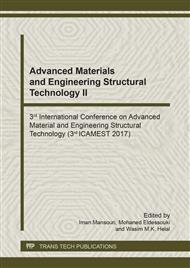[1]
P. Mäki-Arvela, T. Salmi, M. Sundell, K. Ekman, R. Peltonen, J. Lehtonen, Comparison of polyvinylbenzene and polyolefin supported sulphonic acid catalysts in the esterification of acetic acid, Appl. Catal. A- Gen. 184 (1999) 25-32.
DOI: 10.1016/s0926-860x(99)00081-2
Google Scholar
[2]
L. C. W. Baker, D. C. Glick, Cheminform Abstract: Present general status of understanding of heteropoly electrolytes and a tracing of some major highlights in the history of their elucidation, Chem. Rev. 98 (1998) 3.
DOI: 10.1021/cr960392l
Google Scholar
[3]
K. Qiao, H. Hagiwara, C. Yokoyama, Acidic ionic liquid modified silica gel as novel solid catalysts for esterification and nitration reactions, J. Mol. Catal. A-Chem. 246 (2006) 65-69.
DOI: 10.1016/j.molcata.2005.07.031
Google Scholar
[4]
Z. Wu, Z. Li, G. Wu, L. Wang, S. Lu, L. Wang, H. Wan, G. Guan, Brønsted acidic ionic liquid modified magnetic nanoparticle: an efficient and green catalyst for biodiesel production, Ind. Eng. Chem. Res. 53 (2016) 3040–3046.
DOI: 10.1021/ie4040016
Google Scholar
[5]
Z. Xu, H. Wan, J. Miao, M. Han, C. Yang, G. Guan, Reusable and efficient polystyrene-supported acidic ionic liquid catalyst for esterification, J. Mol. Catal. A-Chem. 332 (2010) 152-157.
DOI: 10.1016/j.molcata.2010.09.011
Google Scholar
[6]
J. Yang, L. Zhou, X. Guo, L. Li, P. Zhang, R. Hong, T. Qiu, Study on the esterification for ethylene glycol diacetate using supported ionic liquids as catalyst: Catalysts preparation, characterization, and reaction kinetics, process, Chem. Eng. J. 280 (2015).
DOI: 10.1016/j.cej.2015.05.096
Google Scholar
[7]
Q. Zhang, J. Luo, Y. Wei, ChemInform Abstract: A silica gel supported dual acidic ionic liquid: an efficient and recyclable heterogeneous catalyst for the one-pot synthesis of amidoalkyl naphthols, cheminform, 42 (2011) 2246-2254.
DOI: 10.1002/chin.201114102
Google Scholar
[8]
J. Yang, Q. Li, J. O. Jensen, C. Pan, L. N. Cleemann, N. J. Bjerrum, R. He, Phosphoric acid doped imidazolium polysulfone membranes for high temperature proton exchange membrane fuel cells, J. Power Sources. 205 (2012) 114-121.
DOI: 10.1016/j.jpowsour.2012.01.038
Google Scholar
[9]
J. Yang, J. Wang, C. Liu, L. Gao, Y. Xu, Q. Che, R. He, Influences of the structure of imidazolium pendants on the properties of polysulfone-based high temperature proton conducting membranes, J. Membr. Sci. 493 (2015) 80-87.
DOI: 10.1016/j.memsci.2015.06.010
Google Scholar


